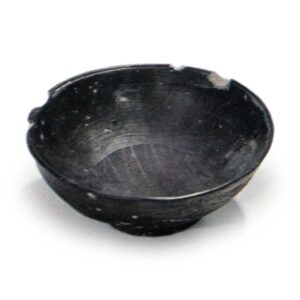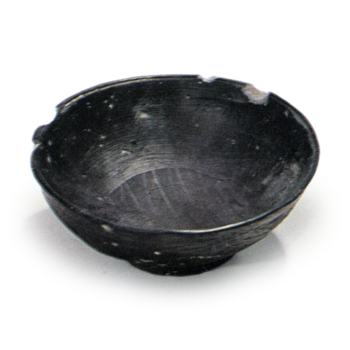
vGrayish-black soft earthenware used in the Kinki region from the Heian to Muromachi periods. It is the successor to black earthenware.
The grayish-black color is the result of smoking in the kiln, and when viewed from the cut surface, it is confined to the surface layer of the vessel wall, while the core is almost white-gray in color. The majority of the wares are bowls with bases and shallow dishes, and other types of wares are rare.
The distinctive feature of this tile ware is the linear burnishing, a few millimeters wide, applied with a spatula to the inner surface of the mouth rim. This burnished area has a silvery luster as if rubbed with a dark pencil. On the interior and exterior surfaces of the mouth rim, there are merely a series of horizontal abrasive lines, but on the interior surface of the bottom, the abrasive lines are used to create dark patterns such as lattice, oblique lattice, parallel lines, zigzag, and spiral patterns. The distribution of tile ware is concentrated in the five Kinai regions of Yamashiro, Yamato, Kawachi, Izumi, and Settsu, as well as Iga and Kii, with only a few examples found in the surrounding areas of Ise, Omi, Tanba, Tango, Tajima, Harima, Bizen, Aki, Awaji, Awa, and Tosa. In the Kinai region, they are uniformly found regardless of the type of site, such as villages, temples, or tombs, indicating that they served as universal daily vessels. There are two theories regarding the transition of tile vessels: one divides them into 15 types and assigns a date from the early 12th century to the mid-15th century, and the other divides them into 10 types in three stages and assigns a date to the latter half of the 11th century. The early bowls with a pedestal have a diameter of 15 or 16 cm and a height of around 6 cm, but as time goes by, they gradually become smaller, finally reaching a diameter of 10 cm and a height of around 3 cm. In addition, the height of the bowls degenerated and disappeared, and the decoration gradually became simpler. However, since the form, quantity, and technique were consistent from period to period, it is thought that they were produced in large quantities in a standardized and concentrated manner. The production scale is estimated to be larger than the scale of earthenware production at one place in one country.



